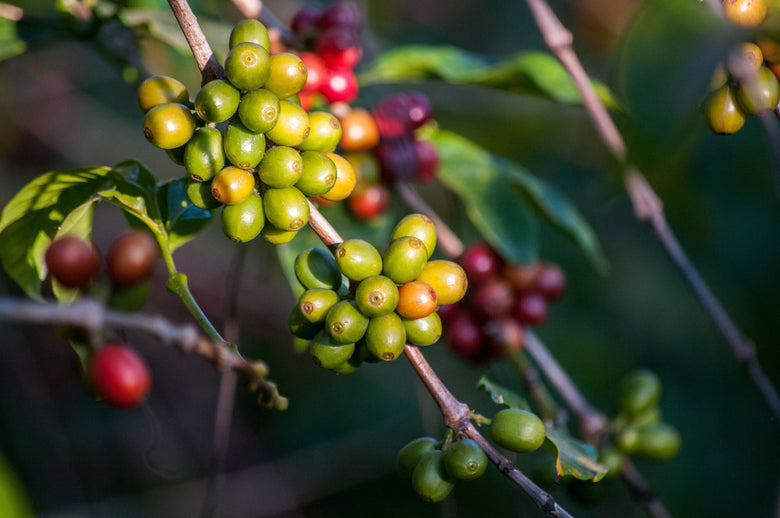The specialty coffee revolution has awakened a new fascination in the journey of the coffee bean. All the sudden, people are beginning to realize that coffee isn’t manufactured in a plant - it is a plant.
Who knew?
The journey of the coffee bean is complex, diverse, and deeply personal. No matter how corporate coffee can feel in the US, coffee is created by people.
Let me give you a good look at how incredible the seed to cup process is by walking you through the stages and hands that produce your daily brew.
Coffee Is A Plant
It all begins with a seed in the ground. Actually, it’s an unprocessed, unroasted green coffee bean. Yes. Beans are seeds!
Originally from Ethiopia and Yemen, coffee now spans the globe: Africa, Asia, South America, Central America, and even California.
Read: Skip The Coffee Aisle, Here's How To Find The World's Best Coffee
Each growing region produces different coffee because of differences in climate, soil, plant genetics, water, bacteria, and a variety of other variables. Even two farms right next to each other can produce wildly different tasting coffee.
Great coffee farms monitor their crops carefully, adjust fertilizers, adapt water cycles, prune plants, and rotate fields every couple decades. Farmers are scientists, but they’re also caretakers who nurture their plants to good health.
2-5 years after being planted, those coffee plants start producing little cherries. Inside these cherries are two coffee seeds (green coffee beans).
Farms employ trained seasonal workers during harvest season to collect ripe cherries. For millions around the globe, these periods of harvesting put food on the table.
All the flavors, aromas, sugars, acids, and other tasting elements are created at the farm. The next stage, processing, allows farmers to manipulate those flavors to achieve their target result.
Read: The Differences Between Arabica And Robusta Coffee
Coffee Bean Processing
Once harvested, coffee beans need to be extracted from the cherries. Coffee bean processing happens 1 of 3 main ways, but every farmer and processing station has their own little spin on the process, depending on resources and goals.
In the natural method, whole cherries are left out to dry on massive patios or raised beds for 2-4 weeks, depending on humidity and rainfall. Once the cherries have dried out, machines rip off the dried cherry and leave only the coffee bean.
This process, since the fruit remains completely attached to the bean for weeks, tends to produce a heavy body, mild acidity, and wild fruit and floral aromas.
The washed method is on the other side of the spectrum in terms of processing and flavor. In this method, the cherry skin and is pulped away immediately. The beans, still sticky with a bunch of sugary mucilage, are fermented in water for 12-72 hours. The mucilage is then washed away and the beans are dried on patios or in drying machines.
This method, since it doesn’t allow much contact time with most of the cherry, eliminates those crazy fruity flavors. However, this makes the natural flavors of the beans themselves pop with more clarity and a brighter acidity.
There are several variations of the honey methods, but they all go something like this. The skin and pulp are removed from the seeds, but quite a bit of the sticky mucilage is left. The seeds are then allowed to dry on patios where the sugars in the mucilage caramelize and turn a dark yellow-black color.
This method produces noticeably sweet coffee with a medium body, medium clarity, and medium acidity. In terms of flavor, it’s a sweet middle ground between washed and natural.
Once the beans are dried to 10-12%, they are ready to be stored and shipped across the world.
Shipping Coffee Beans Around The Globe
Shipping coffee beans isn’t nearly as challenging as it used to be, but there are still hiccups from time to time. The most common issue is moisture buildup while the beans are in transit over the ocean.
If the beans absorb a lot of moisture, the delicate flavors will easily fall apart, strange defect flavors will form, and microbial life may even take hold.
Read: The Easy Guide To Coffee Bean Storage
Most exporters have caught on and use special bags to transport the beans. GrainPro creates one the most popular shipping bags. They’re sealed in such a way that the micro-climate inside is maintained for months at a time. This reduces the risk of insect and microbial growth dramatically compared to mere burlap.
Coffee Roasting - Art And Science
Turning green coffee seeds into roasted coffee beans is an art and a science. Specialty roasters are craftsmen who use their senses and measurement tools to develop the flavors of each coffee.
Keep in mind that roasters do not create flavor. They unlock what’s already available.
Some roasters don’t unlock these flavors very well. But, to be fair, there’s a lot that can go wrong during this stage.
Read: What Does A Coffee Roaster Actually Do?
A difference of just a few degrees for a few seconds can mean the difference between stellar, juicy, sweet coffee and mediocre, “good enough” coffee. Airflow, humidity, temperature, rate of temperature rise, and time affect the coffee while it’s in the roaster.

Finding that perfect balance of variables is the goal to unlock those tasty flavors in a way that’s balanced, delicious, and satisfying. And since every coffee roasts differently, roasting is always a fresh challenge.
And Finally, Brewing
The final step is turning those beans into the elixir of life via espresso machines, french presses, pour over cones, and beyond.
Once again, so much can go wrong here if you’re not careful.
Water that’s too hot will produce bitter coffee. Water that’s too cold with produce sour, weak coffee. Grounds the wrong size won’t brew with balance. Too much calcium in the water will mute all the fun flavors.
This is why specialty coffee is so rewarding and satisfying to brew at home. When you make a rich, sweet, balanced mug, you know that you’ve honored all the stages that came before. You’re the last person in a long line of people who have worked hard to get that perfect mug to you.
Enjoy it, appreciate it, and savor a moment of thanks for all those people along the journey.
---
Coffee’s seed to cup journey is an incredible one - one that inspires much gratitude in me. My daily brew tastes better knowing that hundreds of people played a role in bringing it to me.
Happy brewing!
Images courtesy of amslerPIX.



